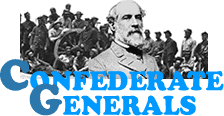BORN: Feb .6 1833
"Laurel Hill", Patrick City, VA.
DIED: 1864 in Yellow Tavern, VA.
CAMPAIGNS: First Bull Run, Peninsula, Seven Days, Malvern Hill, Secon Bull Run, Catlett's Station, Groveton, Antietam, Stuart's Chambersburg Pennsylvania Raid, Fredericksburg, Chancellorsville, Brandy Station, Gettysburg and Yellow Tavern.
HIGHEST RANK ACHIEVED: Major General
|
|
James Ewell Brown Stuart was born on "Laurel Hill," in Patrick County, Virginia. Educated at home and at Wytheville, Virginia; Stuart studied at Emory and Henry College, then attended the US Military Academy at West Point. Graduating from West Point in 1850, he served in the Mounted Rifles and was assigned to Texas by December. Stuart was transferred to the 1st US Cavalry in 1853, and spent most of the next six years in Kansas. In 1855, he married Flora Cooke, the daughter of future Union major general Philip St. George Cooke and was promoted to 1st lieutenant. In the summer of 1859, he traveled east to sell the rights to his invention, a device to hold a cavalry saber to a belt, to the War Department. During this trip, Stuart met with Col. Robert E. Lee, who had been superintendent of West Point when Stuart was a student there. Lee asked Stuart to serve as an aide as Lee was assigned to quell John Brown's raid on the federal arsenal at Harpers' Ferry. After this, Stuart returned to Kansas. In May of 1861, after Virginia seceded, Stuart resigned his commission in the US Army, and became a colonel in the Confederate cavalry. Leading the charge that helped the Confederacy win the First Battle of Bull Run, was promoted to brigadier general on September 24, 1861. He trained his cavalry unit to become a polished and efficient fighting force by the end of 1861. During the Peninsula Campaign, Stuart scouted to find out where the Union forces were located, then rode around the entire Union line rather than return directly. This action cheered up the Confederates, providing them with information on Union whereabouts and demonstrating the scouting capabilities of Confederate intelligence. Stuart led troops in the Seven Days' Campaign, and was promoted to major general on July 25, 1862. Given command of the cavalry of the Army of Northern Virginia right before the Second Battle of Bull Run, he demonstrated superior performance. Stuart also fought well in the Antietam Campaign, although he was unable to destroy an iron bridge over the Conococheague Creek during his Chambersburg (Pennsylvania) Raid. Stuart also participated in the Battle of Fredericksburg, the Chancellorsville Campaign and the Gettysburg Campaign. He was late for the Battle of Gettysburg, however, and his tardiness contributed to the Confederate defeat. In the spring of 1864, however, he stayed in close contact with the rest of the Confederate forces, and kept Confederate Gen. Robert E. Lee informed of Union movements. Stuart was known as the "Cavalier of Dixie," and Lee considered him the "eyes of the army." In May of 1864, Stuart and his troops clashed with Union Maj. Gen. Philip H. Sheridan's forces at Yellow Tavern. During the battle that ensued, Stuart was mortally wounded by a Union cavalryman. Stuart died on May 12 1864, and was buried in Hollywood Cemetery, in Richmond, Virginia.
|

